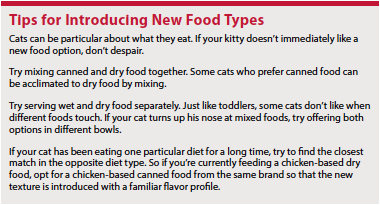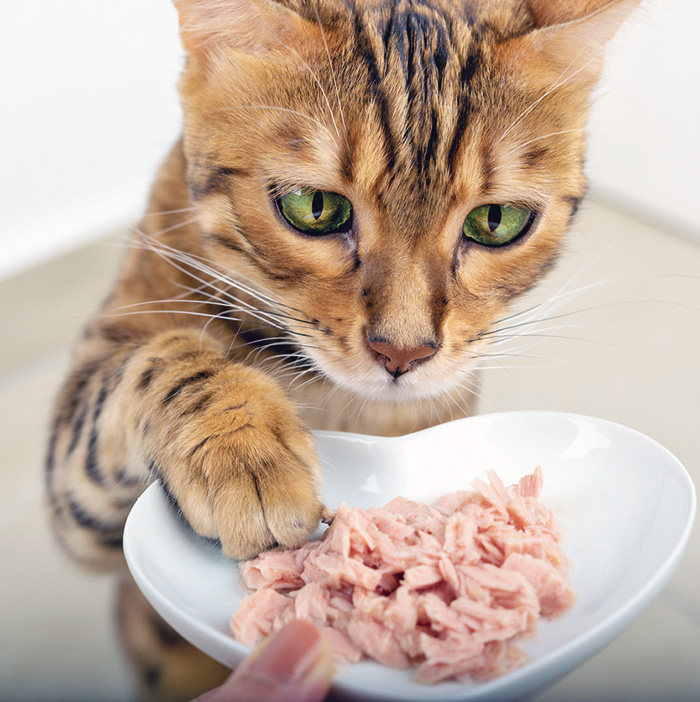We have so many options when it comes to feeding a cat, and this is surely a good thing. It would seem like the first decision is whether to feed a dry (kibble) diet or a wet (canned) diet. But here’s the thing: There are pluses to both types of foods, and you don’t have to pick just one.
Prepare for Anything
“I would say, in general, it’s good to get your cat to eat both early so you can switch to what is needed depending on the health issues with your cat,” says Joseph J. Wakshlag, DVM, PhD, chief of nutrition at Cornell University’s College of Veterinary Medicine. If your cat will willingly eat both canned and dry food, she will have an easier transition if she ever requires a particular diet for a health problem like kidney disease.
Another plus to feeding your cat both wet and dry food is that you have more flexibility in what you can buy for her. As we are still experiencing the periodic issues associated with the stocking and overall supply of pet foods that started with the COVID pandemic. With that in mind, it is a relief to have other food options she will accept if your cat’s first choice food isn’t available.
To feed both wet and dry food, you can put a little canned food on top of your cat’s dry meals, or you can feed dry food at one meal and canned food at the other meal. Another option is to use canned food for your cat’s primary meals but use kibble as treats throughout the day or during training sessions.
When Dry Food Shines
Here are some day-to-day situations in which dry food is ideal:
- Puzzle toys. Kibble falls out easily as your cat manipulates the toy (and makes for easier cleanup).
- Automatic feeders. Most automatic feeders are not able to keep wet food moist over time, making dry food the better choice.
- Chase games. If your kitty needs more exercise as part of a diet, tossing kibbles for her to chase is a fun and easy way to burn some calories.

Dry Food Required
“If your cat has dental disease as a primary issue then it would likely be dry food that wins, particularly a dental formula to help with the teeth,” says Dr. Wakshlag. Firm, crunchy kibbles encourage your cat to chew, which can help to prevent plaque and tartar buildup. Dental diets are specially formulated to promote chewing and reduce plaque. Don’t be put off by the extra-large kibbles. That is intentional to encourage your cat to chew instead of just swallowing them whole.
When Wet Food Shines
Here are some day-to-day situations in which canned food has an edge:
Promoting hydration. If your kitty isn’t big on drinking water, the extra moisture in canned food can help to keep her hydrated.
Staying lean. The higher protein content and higher moisture content of most canned foods can be helpful for cats who have trouble maintaining a healthy weight.
Enticing picky eaters. The stronger aroma of wet foods can stimulate your cat’s appetite and encourage her to eat regular meals.
Wet Food Required
Cats with some health conditions may benefit from feeding a wet food. One example is urinary disorders such as feline lower urinary tract disease or chronic urinary tract infections. “If there are urinary issues then canned wins since the hydration is necessary,” says Dr. Wakshlag. That extra moisture helps to flush your cat’s urinary tract, taking bacteria, crystals, and other debris with it. Prescription canned diets are even better for specific urinary issues.
Chronic kidney disease is another situation in which feeding a canned prescription diet is often ideal. Prescription kidney diets are the only diets adequately formulated to forestall the progression of kidney disease, and canned diets have the bonus of helping to keep your cat well-hydrated.
Diabetic cats and other kitties who struggle with weight loss may also benefit from a wet food diet. The higher moisture content can make canned diets less calorie dense than many dry foods, making your cat feel fuller when eating the same number of calories of wet food versus dry.
A word of caution, however: Calorie content of cat foods can vary widely, regardless of whether they are wet or dry. If your cat needs a weight loss plan, discuss food options with your veterinarian to determine which food is the best fit for your situation.




